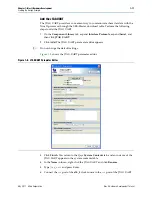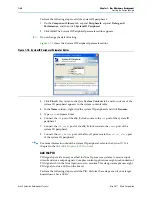
1–22
Chapter 1: Nios II Hardware Development
Creating the Design Example
Nios II Hardware Development Tutorial
May 2011
Altera Corporation
7. Connect the
clk_reset
port of the
clk_0
clock source to the
reset
port of the PIO.
8. Connect the
data_master
port of the Nios II processor to the
s1
port of the PIO.
9. In the
external_connection
row, click
Click to export
in the
Export
column to
export the PIO ports.
f
For more information about the PIO, refer to the
PIO Core
.
Specify Base Addresses and Interrupt Request Priorities
At this point, you have added all the necessary hardware components to the system.
Now you must specify how the components interact to form a system. In this section,
you assign base addresses for each slave component, and assign interrupt request
(IRQ) priorities for the JTAG UART and the interval timer.
Qsys provides the
Assign Base Addresses
command which makes assigning
component base addresses easy. For many systems, including this design example,
Assign Base Addresses
is adequate. However, you can adjust the base addresses to
suit your needs. Below are some guidelines for assigning base addresses:
■
Nios II processor cores can address a 31-bit address span. You must assign base
address between 0x00000000 and 0x7FFFFFFF.
■
Nios II programs use symbolic constants to refer to addresses. Do not worry about
choosing address values that are easy to remember.
■
Address values that differentiate components with only a one-bit address
difference produce more efficient hardware. Do not worry about compacting all
base addresses into the smallest possible address range, because this can create
less efficient hardware.
■
Qsys does not attempt to align separate memory components in a contiguous
memory range. For example, if you want an on-chip RAM and an off-chip RAM to
be addressable as one contiguous memory range, you must explicitly assign base
addresses.
Qsys also provides an
Assign Interrupt Numbers
command which connects IRQ
signals to produce valid hardware results. However, assigning IRQs effectively
requires an understanding of how software responds to them. Because Qsys does not
know the software behavior, Qsys cannot make educated guesses about the best IRQ
assignment.
The Nios II HAL interprets low IRQ values as higher priority. The timer component
must have the highest IRQ priority to maintain the accuracy of the system clock tick.
To assign appropriate base addresses and IRQs, perform the following steps:
1. On the System menu, click
Assign Base Addresses
to make Qsys assign functional
base addresses to each component in the system. Values in the
Base
and
End
columns might change, reflecting the addresses that Qsys reassigned.
2. In the
IRQ
column, connect the Nios II processor to the JTAG UART and interval
timer.
3. Click the IRQ value for the
jtag_uart
component to select it.
4. Type
16
and press Enter to assign a new IRQ value.
















































